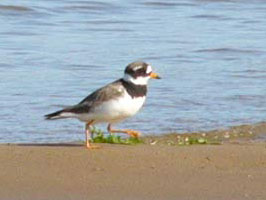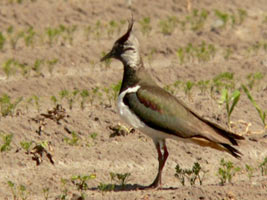Ringed Plover (Ring dotterel)
(Charadrius hiaticula)

This bird is a little bit less than the starling. On its breast there is a black "tie"; the beak is yellow at the basis and has a black tip.
It nests on sandy coast, more often — on seaside.
Males sing repeating only one stanza. They start slowly, but gradually accelerate — and in the end they sing almost without pauses. Their voice is melodious "kyuik". They sing their song during courtship display flight, frequently flapping by wings.
The nest of this bird is simply a pit in sand, located almost at the border of water. Sometimes it is lined with little stones. The clutch is incubated by both parents; they frequently replace each other.
The ringed plover feeds on little animals living in water. It finds them on the surface of sand. Or birds stir up the silt in water by the legs, and then catch its escaping inhabitants.
Lapwing (The Northern Lapwing, Peewit)
(Vanellus vanellus)
The lapwing is one of the first messengers of spring. It is similar to the pigeon in size — and is very beautiful! The back of its body is black-greenish with shine. Its belly is white with reddish; the tail is white with a wide black strip; the wings are wide, from below — white with black ends. On the head there is a graceful crest.
It nests on fields, damp meadows and grassy bogs, sometimes — in small colonies.
In mating season, males make demonstrative flights with flapping of the wings and cries "chi-vy, chi-vy ".

.jpg)